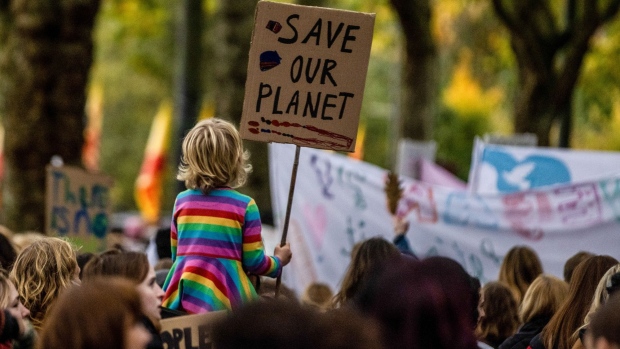Oct 19, 2022
Keeping Climate Change Under Control Requires Six Times More Ambition
, Bloomberg News

(Bloomberg) -- The international community needs to be six times more ambitious than it has been in the past year if it wants to avoid catastrophic climate change and keep global warming at 1.5 degrees Celsius by the end of the century.
If fulfilled, the latest round of climate pledges made by countries would result in an additional emissions reduction of 5.5 billion metric tons of carbon dioxide equivalent, compared with the initial round of commitments, according to a report by nonprofit World Resources Institute released on Wednesday.
“Countries have expanded their targets to cover more sectors and more types of greenhouse gases,” lead author Taryn Fransen said in a statement. But “the emissions impact of these improvements has been modest—more than 85% of the improvement has come from large countries ratcheting up the stringency of their existing targets.”
The international community committed in 2015 in Paris to take steps to reduce greenhouse gas emissions to keep the warming of the planet below 2C and close to 1.5C by the end of the century, compared with average temperatures in pre-industrial times. But even if all current policies are implemented, the planet is heading toward a catastrophic warming of 3C, with the effects of climate change already showing in deadly extreme weather events that are hitting every continent.
Emissions from human activities must fall at least 43% from 2019 levels by 2030 to keep the 1.5C goal within reach, according to analysis by scientists at the UN-backed Intergovernmental Panel on Climate Change. New commitments only cut emissions by 7%, meaning they would have to be six times more ambitious to align with the goals in the Paris Agreement, according to WRI’s analysis.
In total, 81% of country climate plans, also known as Nationally Determined Contributions or NDCs, set targets for renewable energy, but only 51 include measures related to consumption of fossil fuels, and just eight contemplate phasing out or phasing down fossil fuels.
In similar fashion, national targets include measures to promote electric mobility, but shy away from critical measures to reduce transport emissions, which accounted for about 37% of human emissions globally in 2021, according to the International Energy Agency.
“A holistic approach to reducing emissions from transport includes avoiding unnecessary vehicle travel, shifting to efficient travel modes, and improving vehicle and fuel efficiency,” Fransen said. “The enthusiasm for e-mobility, however, was not matched by growth in other critical transport-related measures.”
Last year during UN-sponsored COP26 climate talks in Glasgow, 119 countries signed the Global Methane Pledge agreeing to collectively reduce global methane emissions by 30% by 2030, from 2020 levels. Methane is a powerful greenhouse gas, with a capacity to trap about 80 more heat than carbon dioxide during its first 20 years in the atmosphere, so eliminating these emissions would help the international community achieve its goal faster.
While around 80% of signatories to the pledge include methane under their wider emissions reductions targets, only 15 include quantified targets specific to methane, raising questions on how the collective goal will be met, according to the WRI report.
Climate finance needs by developing nations, expected to be a contentious issue at the COP27 meeting in Sharm el-Sheikh, Egypt, this year, are much higher than the $100 billion a year that rich countries committed to give them—a promise that has never been fulfilled. Only around half of the NDCs reported climate finance requirements, and they are already estimated to cost $4.3 trillion to implement, the report says.
©2022 Bloomberg L.P.








